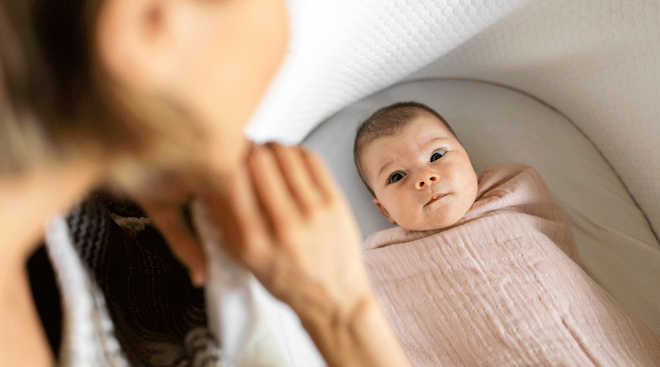Why Baby Gets Extra Cranky at Five Weeks
Just when you think you and baby had this great thing going, he or she becomes clingy and cranky. Chalk up the change in temperament to back-to-back growth spurts.
Around the five-week mark, babies enter what some experts call a “wonder week,” a period of marked mental and physical development, explains Terra Blatnik, MD, a pediatrician at Cleveland Clinic Children’s Hospital. Your infant is getting better control over his or her head and upper body and may even be able to lift his or her head up when lying on your chest. You’ll also see his or her first social smile. As babies gear up to make those big changes, his or her mood can sometimes be affected.
Hot on the wonder week’s heels is the six-week growth spurt, when baby will have a quick increase in weight, length and head circumference. He or she might also be packing on some adipose tissue, better known as those cute, chubby rolls, on her legs, arms and belly.
During a growth spurt, baby needs more milk and will cry to let you know they’re hungry (which can be a lot). “Instead of feeding every two or three hours, they may feed every hour or two,” says Blatnik. “This is also a peak time for colic due to gassiness. All these things combined can make for a very fussy newborn.”
Because baby’s going through a transformation, the wonder week is a good time to give him or her new opportunities to learn. Let baby explore his or her environment through touch, smell and sight. Bring out a different toy or take them somewhere new, even if that just means strolling down a different street in your neighborhood. Have tummy-time sessions with baby, since they stimulate learning and strength.
Also, give baby extra attention. Accept that there will be additional feedings, and build in time for cuddling and holding, especially at bedtime. “Babies like a sense of closeness with mom and dad, so using an infant carrier can help. Movement will soothe the infant and may ease some fussiness,” Blatnik says.
Remember: You and your partner could use a little extra love too. All the extra feedings and crying jags are probably translating into a stretch of sleepless nights. So take turns napping, forget the dishes or laundry and get shut-eye whenever you can. (If you’re concerned with baby’s fussiness, call the pediatrician. Sometimes an illness or ear infection can cause a change in temperament.)
Please note: The Bump and the materials and information it contains are not intended to, and do not constitute, medical or other health advice or diagnosis and should not be used as such. You should always consult with a qualified physician or health professional about your specific circumstances.
Plus, more from The Bump:
Navigate forward to interact with the calendar and select a date. Press the question mark key to get the keyboard shortcuts for changing dates.




















































